source(google.com.pk)
Nigerian Traditional Dress Styles Biography
Traditional clothing separates social classes and regional groups. It is standard, and its costumes symbolise a community and constancy. It never changes. City and rural dwellers in Nigeria can distinguish the Eastern way of dressing from that of the Northern or Western as each identifies with the various ethnic groups.
Traditional clothing hardly ever changes. If any change occurs, it is only in very little details, and this can be very slow. It hardly expresses individual personality as it indicates group membership and is timeless.
Fashion, on the other hand, is not standard as it derives its appeal from its transience nature. However, fashion emphasises belonging to a certain social stratum but it expresses individual personality.
In the late middle age, the bourgeois and the aristocrats began to use clothing not only to separate themselves from other social classes and assert their social positions they also used it to express their individuality. That was when the word fashion became a concept.
Nigerian Fabrics
Tie and Dye
Dyeing is one industry done for Nigeria, not for tourists, as it is not highly demanded by them. The trade thrives, largely in the North so much that it used to compete with imported textiles.
The Yoruba like bright colours from overseas. So, the demand for the local cloth, though persistent among them, is slim.
Some big towns in the north like large spaces for dye-pits. A dyer has several of these pits, each about eight feet deep, some for actual dyeing, and one or two for rinsing.
The noticeable aroma of indigo, now used together with airline indigo from Europe lies over the place, as the dye is often allowed to accumulate and become stale.
Nigerians have not entirely switched over to airline dye because being fast, it does not come off the skin, which is seen as an undesirable side effect.
The clothes are left lying in the mixture for a day or two, then rinsed and dried by being laid out on the surface. Now, the pits are generally walled with cement, as in Kano.
In the North, it is easy to notice chiefs and notable people in deep blue shiny turbans locally wound round their heads, which give a rich appearance to their attire.
This is a property of the cloth imparted to it, not gloss. This is done when the cloth is first dyed indigo by dipping several times until saturation point. The indigo contents is then increased further by a technique similar to the much more ancient- some say pre-textile method- making basic cloth. The cloth is laid over a tree trunk and beaten vigorously with heavy mallets or beaters. Liberal amounts of dry indigo in powdered form are then sprinkled on and so it and so it becomes the main vehicle of the gloss.
The Yoruba are adept at pattern dyeing which they call adire. There are different techniques though they are all based on the same principle of reservation of certain areas of the cloth from the dye, so that the pattern is seen in white or in lighter blue of the blue background. The reservation may be effected by tying small stones or seeds into it or by the resist method, in which cassava starch is pointed on the cloth either by free hand or through stencils. Before, it used to be of leather, then of zinc and now of tin.
Among the Yoruba, the traditional colour for wrapped skirts, loose blouses and headties is blue, the colour of indigo. In most Yoruba markets are rolls of cloth with beautiful patterns. Mostly the women who dye them sell them. Men and the youth also engage in this business. They concentrate in-groups around canals boiling, beating, tying and beating the cloths.
Small circular designs are made in some tie-dyed cloth, by pinching up lots of the materials and tying them with raffia or thread before dying.
To produce the larger designs, tucks are made in the cloth and tightly sewn. When the dyers dip the white cloth into their big drums, the indigo (now varieties of colours are used) cannot soak into the tied and sown parts. The result shows white after the cloth is dried up and the stitching and raffia taken out. Then another dipping will stain the white designs in a soft pale blue or in a different colour entirely.
The patterns have a name each. There is ” The meeting place of roads,” a cross-shaped pattern in the centre of a cloth. A spiral shape of beads is called “welcome to the masquerade.”
There are resist-dyed clothes in which patterns are painted on free hand or using a metal stencil. A feather or a rib of palm-leaf can serve as a brush and the print can be a mixture of alum and starchy cassava that protects the cloth from dye. The patterns come out white when the paint is scrapped off and the cloth has been dipped in the indigo. There are geometric patterns, figures of men and animals, or leathers of the alphabet. Combinations of designs give rise to each name one can be called “All the birds are here” and another “We enjoy Ibadan.”
Ibadan and Abeokuta are some of the big cities in Nigeria that are centres of dyeing adire cloths. Many countries in West African sub-region also have them in the their markets, far away from the Yoruba area. The dyers of adire work with machine-made cotton materials but hand woven clothes can also be found in the market.
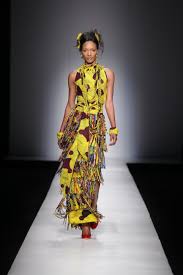
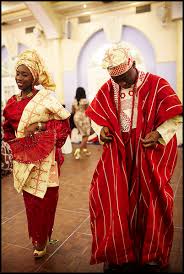



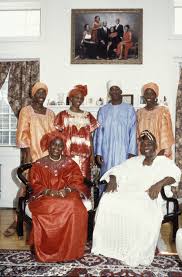
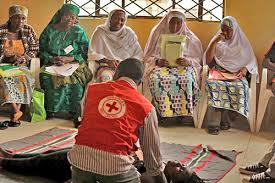

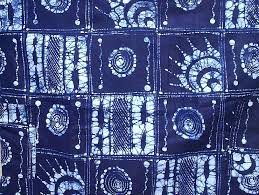
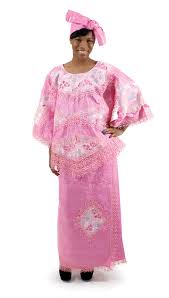
Nigerian Traditional Dress Styles Biography
Traditional clothing separates social classes and regional groups. It is standard, and its costumes symbolise a community and constancy. It never changes. City and rural dwellers in Nigeria can distinguish the Eastern way of dressing from that of the Northern or Western as each identifies with the various ethnic groups.
Traditional clothing hardly ever changes. If any change occurs, it is only in very little details, and this can be very slow. It hardly expresses individual personality as it indicates group membership and is timeless.
Fashion, on the other hand, is not standard as it derives its appeal from its transience nature. However, fashion emphasises belonging to a certain social stratum but it expresses individual personality.
In the late middle age, the bourgeois and the aristocrats began to use clothing not only to separate themselves from other social classes and assert their social positions they also used it to express their individuality. That was when the word fashion became a concept.
Nigerian Fabrics
Tie and Dye
Dyeing is one industry done for Nigeria, not for tourists, as it is not highly demanded by them. The trade thrives, largely in the North so much that it used to compete with imported textiles.
The Yoruba like bright colours from overseas. So, the demand for the local cloth, though persistent among them, is slim.
Some big towns in the north like large spaces for dye-pits. A dyer has several of these pits, each about eight feet deep, some for actual dyeing, and one or two for rinsing.
The noticeable aroma of indigo, now used together with airline indigo from Europe lies over the place, as the dye is often allowed to accumulate and become stale.
Nigerians have not entirely switched over to airline dye because being fast, it does not come off the skin, which is seen as an undesirable side effect.
The clothes are left lying in the mixture for a day or two, then rinsed and dried by being laid out on the surface. Now, the pits are generally walled with cement, as in Kano.
In the North, it is easy to notice chiefs and notable people in deep blue shiny turbans locally wound round their heads, which give a rich appearance to their attire.
This is a property of the cloth imparted to it, not gloss. This is done when the cloth is first dyed indigo by dipping several times until saturation point. The indigo contents is then increased further by a technique similar to the much more ancient- some say pre-textile method- making basic cloth. The cloth is laid over a tree trunk and beaten vigorously with heavy mallets or beaters. Liberal amounts of dry indigo in powdered form are then sprinkled on and so it and so it becomes the main vehicle of the gloss.
The Yoruba are adept at pattern dyeing which they call adire. There are different techniques though they are all based on the same principle of reservation of certain areas of the cloth from the dye, so that the pattern is seen in white or in lighter blue of the blue background. The reservation may be effected by tying small stones or seeds into it or by the resist method, in which cassava starch is pointed on the cloth either by free hand or through stencils. Before, it used to be of leather, then of zinc and now of tin.
Among the Yoruba, the traditional colour for wrapped skirts, loose blouses and headties is blue, the colour of indigo. In most Yoruba markets are rolls of cloth with beautiful patterns. Mostly the women who dye them sell them. Men and the youth also engage in this business. They concentrate in-groups around canals boiling, beating, tying and beating the cloths.
Small circular designs are made in some tie-dyed cloth, by pinching up lots of the materials and tying them with raffia or thread before dying.
To produce the larger designs, tucks are made in the cloth and tightly sewn. When the dyers dip the white cloth into their big drums, the indigo (now varieties of colours are used) cannot soak into the tied and sown parts. The result shows white after the cloth is dried up and the stitching and raffia taken out. Then another dipping will stain the white designs in a soft pale blue or in a different colour entirely.
The patterns have a name each. There is ” The meeting place of roads,” a cross-shaped pattern in the centre of a cloth. A spiral shape of beads is called “welcome to the masquerade.”
There are resist-dyed clothes in which patterns are painted on free hand or using a metal stencil. A feather or a rib of palm-leaf can serve as a brush and the print can be a mixture of alum and starchy cassava that protects the cloth from dye. The patterns come out white when the paint is scrapped off and the cloth has been dipped in the indigo. There are geometric patterns, figures of men and animals, or leathers of the alphabet. Combinations of designs give rise to each name one can be called “All the birds are here” and another “We enjoy Ibadan.”
Ibadan and Abeokuta are some of the big cities in Nigeria that are centres of dyeing adire cloths. Many countries in West African sub-region also have them in the their markets, far away from the Yoruba area. The dyers of adire work with machine-made cotton materials but hand woven clothes can also be found in the market.
Nigerian Traditional Dress Styles
Nigerian Traditional Dress Styles
Nigerian Traditional Dress Styles
Nigerian Traditional Dress Styles
Nigerian Traditional Dress Styles

Nigerian Traditional Dress Styles
Nigerian Traditional Dress Styles
Nigerian Traditional Dress Styles
Nigerian Traditional Dress Styles
Nigerian Traditional Dress Styles
Nigerian Traditional Dress Styles
No comments:
Post a Comment